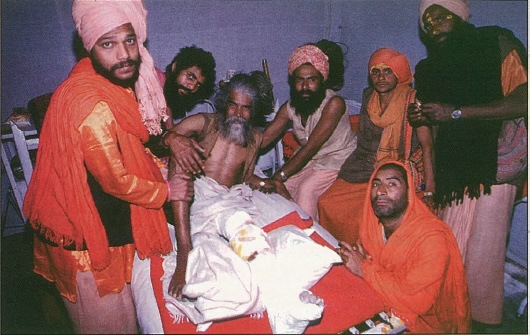The official report is that a hundred holy men were injured but none killed in the clash between two monastic orders on March 28 in Haridwar at the Kumbha Mela. Yet Sadhvi Meera Puri of Juna Akahara told Hinduism Today correspondent Rajiv Malik, “There was a clash, and many dead bodies were seen in the aftermath of it. I heard the sound of bullet shots even from here, where I sit now.” This wasn’t the first such clash of militant ascetics in the history of the Mela, nor nearly the deadliest [see Timeline page 34]. The issue has always been the same, the order in which each of the 13 akharas take their sacred bath on the auspicious day. As elsewhere, it’s a matter of rank and of ego as to who goes first.
“The incident happened,” Swami Nirbhaya Puri of Niranjani Akhara, told Hinduism Today, “because the people coming from our backside in the procession, that is, the Juna Akhara, were not stopped from coming forward. Fifty feet was supposed to be kept between us by the police. This started the problem. Then, instead of taking their own route back from the ghats, Juna Akhara followed us and tried to stop our procession. There was a fight between a few of our sadhus and theirs, both were hurt. Then they set fire to our gate, and we pelted them with stones. The police came, and it turned into a fight between the police and the Juna Akhara sadhus. It was total anarchy. On that day people literally fled from Haridwar. A wrong message went out to the common man.” As a result, the Mela administration banned the next procession of sadhus, scheduled for April 14. At the last minute, the ban was lifted, but the Juna Akhara and its allies boycotted the procession.
There was widespread criticism of the fight. Typical was the lament of Mahant Govind Das of the Bada Udasin Akahara, “Society has given us a lot of love and affection, but what we have given them by this incident we must think. We have spoiled the grace and serenity of sainthood.”
Militant sadhu orders have existed for a thousand years. Fights among them could be likened to jealous clashes between rival branches of a country’s military forces. But there is no longer a need, as there was even a hundred years ago, for ascetics to be armed for their own and others’ protection against hostile elements and foreign invaders. The government now provides that security, and these fights are the last vestige of a tradition past its time. Defense of dharma today requires mental, not physical, armament.
SUCCESSION
ABBOT ATTACKED DURING MELA
ASSAILANTS UNKNOWN
On the same day as the clash between two sadhu orders, Swami Madhvashram was brutally attacked in his Haridwar ashram. After he was knocked to the floor, to save his life a quick-thinking lady devotee covered him with a sheet and wailed, “He’s dead!” The attackers then ransacked the ashram, burned six cars and fled. Madhvashram is one of three claimants to the position of Shankaracharya of Jyotir Mutt in Badrinath, one of four cardinal monasteries that Adi Shankara established in the 8th century. Naga sadhus were blamed, but Swami has another theory. “Those who attacked me were hired hooligans who were given the garb of Nagas,” he told Hinduism Today in an exclusive interview in New Delhi. “I believe this mob of 125 people was hired to kill me by Swami Swaroopanand and Swami Vasudevanand [rival claimants to the post–both deny the charge]. My disciples heard a lady in Haridwar scold her husband, ‘You posed as a naked sadhu, took so much risk and got just 300 rupees.'”
The Shankaracharyas of the other three mutts were asked to comment, but only Swami Nischalanand of Puri in Orissa, responded. He told Hinduism Today, “This act should be condemned by everybody and the guilty punished. The feud over the mutt has been going on for many years. All concerned should meet and reach an amicable settlement acceptable to all.”
